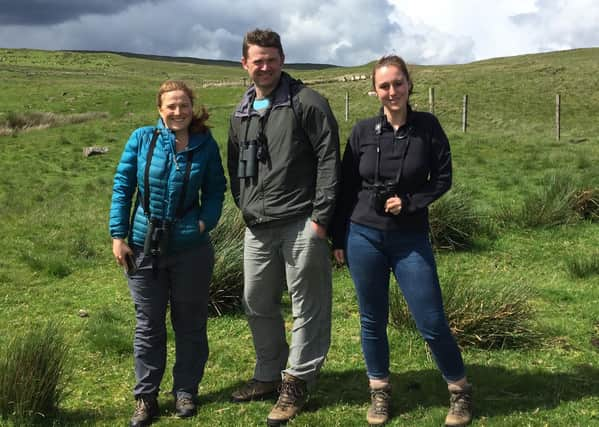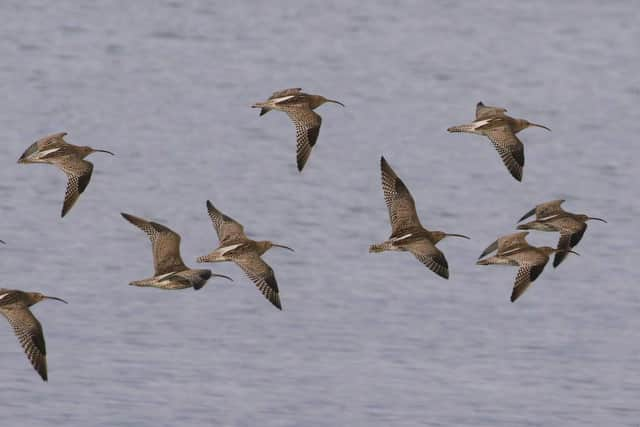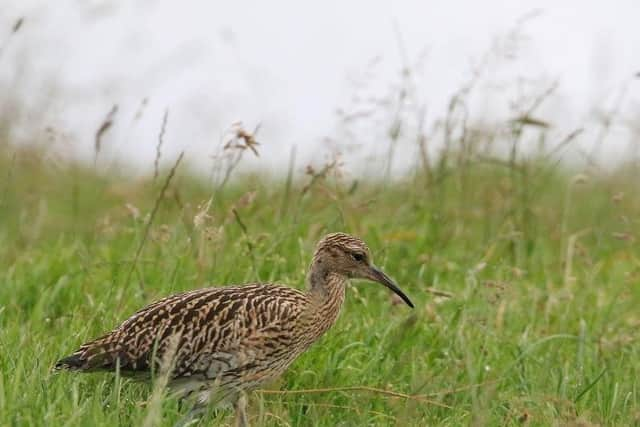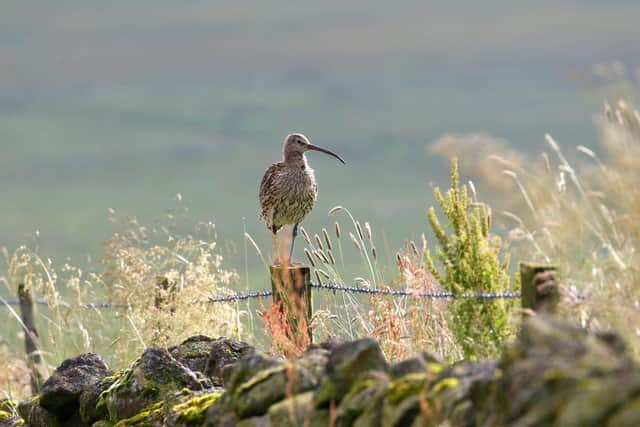Curlew’s evocative call is increasingly becoming rare across the British Isles


The curlew belongs to a group of birds known as “waders”, because they spend parts of their life wading in shallow waters. Its long, downcurved bill is an unmistakeable feature and perfect for probing the mud for prey.
The haunting call of the curlew has inspired poets and songwriters from Dylan Thomas to Benjamin Britten.
Advertisement
Advertisement
But sadly the famously evocative and previously familiar call of the curlew is becoming increasingly rare across the United Kingdom. In December 2015 the species was added to the UK red list and it is argued to be the most pressing bird conservation priority in the UK.


Today, their breeding range has contracted and they are more often thought of as a bird of the uplands, breeding on moorland areas and farms around the hill edge. The UK’s breeding curlew population has halved in the last 25 years.
This decline has also been recorded in most of the other countries where curlew breed. It is estimated by the International Union for the Conservation of Nature (IUCN) that worldwide there has been a 20-30% reduction in curlew breeding numbers in the past 15 years. Curlew are now considered to be vulnerable on the European red list, meaning that the species face a high risk of extinction.
Speaking to Farming Life from her home in Ballynure via Zoom RSPB NI’s Katie Gibb gave further details on the plight of the curlew ahead of World Curlew Day (Tuesday, April 21st).
Advertisement
Advertisement
She said: “The global population is estimated to number circa 835,000-1,310,000 individuals (Wetlands International 2016).


“The European population is estimated at 212,000-292,000 pairs, which equates to 425,000-584,000 mature individuals (BirdLife International 2015) and is roughly equivalent to 647,500-876,000 individuals.”
The situation in Northern Ireland is also very worrying, explained Katie. She said: “The numbers that we have from Northern Ireland surveys are mid 1980s – 5,000 pairs, late 1990s-2,090 pairs, 2013 (last official population estimate): 526 pairs.
“The Antrim Hills were surveyed by RSPB and NIEA staff in 2017, which produced an estimate of 61 pairs.
Advertisement
Advertisement
“In Northern Ireland we now estimate that the population has further declined to around 200 pairs.”


Katie noted that there was a range of potential causes which have been attributed to the declines in the curlew populations.
She remarked: “The declines and range contractions reported here in Northern Ireland have been associated with intensified pastoral farming and loss and fragmentation of peatland habitat.
“Increased livestock densities, drainage, regular cutting and high fertiliser leading to reduced food availability, increased predation and loss of nests and chicks through trampling by livestock or mechanical cutting are all thought to be partially responsible for the observed low breeding densities and breeding success.
Advertisement
Advertisement
“Loss, degradation and fragmentation of peatland are further causes for the large decline.”
Katie continued: “Afforestation of the moorlands by commercial conifer plantations are thought to have an effect as well, with increasing habitat loss and providing habitat for predators.
“An RSPB study in Northern Ireland identified high levels of predation on nests as one of the main causes of the population decline, with foxes and hooded crows being the most important predators.
“Similar findings have been obtained from declining populations elsewhere in Europe, suggesting that increases in predator populations have also contributed to declines.”
Advertisement
Advertisement
Another important contributor to curlew decline is climate change.
Katie commented: “Climate change is another potential cause of the declines with declines predicted in the UK population by 2080 as a result of drier conditions, and evidence that populations have shown a significant upward shift in elevation through time.
“The effects of climate change may reduce the availability of invertebrate food resources for both adults and chicks, especially on peatland.
“Annual adult survival rates are high 82-95%, which suggests a low reproductive success rate is the likely demographic driver of the population declines we are seeing.
Advertisement
Advertisement
“The causes here are all likely to impact reproductive success on some level, either by reducing nesting habitat suitability and quality, reducing the availability and quality of foraging habitat for chicks or increasing the vulnerability of nests and chicks to predation, either directly or indirectly.”
Despite RSPB NI being worried about the declines in curlew numbers here in Northern Ireland, explained Katie, the charity is optimistic about the conservation work which can be applied to these areas.
“The declines that you see here in Northern Ireland and Wales are very worrying there is no question about that. But because both Northern Ireland and Wales are relatively small areas we are able to address those declines more promptly.
“There is a lot of research being carried out into why the species is declining and how we can help them.
Advertisement
Advertisement
“In Glenwherry in Co Antrim there is the curlew trial management project, which is research which is looking into habitat management and predatory control and how that helps with curlew population in the area.
“We are working as quickly and as smartly as we can, to ensure that the population declines that we have witnessed do not get worse and that the decisions that we make are based on science.”
What RSPB NI are doing at Glenwherry has been very specific to that area, said Katie.
She commented: “At Glenwherry it is very much farmland, while schemes elsewhere in the UK they are in the really wild moorland areas. How we work in Glenwherry is dictated by the need to work so much more closely with the farmers.
Advertisement
Advertisement
“The farmers that I have had the opportunity to work for have been fantastic.
“ They are very passionate and are always open to suggestions to how they might be able to improve habitat for the curlew by their farming practices.
“We have found that they have been very willing to work with RSPB NI to get their businesses as wildlife friendly as possible.
“We have a number of projects which are ongoing with the farmers at Glenwherry.
Advertisement
Advertisement
“The main one is the EFS (Environmental Farming Scheme – led by DAERA), all of our farmers are eligible to enter into the higher scheme.
“This has allowed us to formulate a group rather than it being individual farms as well as landscape conservation.
“It means that the work that we are doing is much more collective and far less fragmented.
“The farmers have been very engaging. A perfect example of that, with the Covid-19 crisis I am unable to go out and survey, the problem is that having a year’s gap in surveys would be so devastating to the conservation work that we are engaged in, but all of the farmers have come forward and have said that they would monitor the birds for us.
Advertisement
Advertisement
“I have been busy putting together a citizen science pack for the farmers, and they are now ringing me up and telling me what they have seen or heard on their land, I am definitely talking more to them now than I would normally.”
Katie added: “I would say that they would probably know the birds better than we do. In this time of crisis they have very much become my eyes and ears.”
This coming Tuesday it is World Curlew Day and it is a great opportunity to highlight the plight of the great wader and get people to stop and think about conserving the bird.
Katie explained: “The date of World Curlew Day, April 21st, was chosen because it’s the feast day of the Welsh saint Beuno.
Advertisement
Advertisement
“In myth we are told that the curlew swooped down and saved the saint’s prayer book. It’s a nice connection to nature and the saint, and of course now it is our turn to help save the curlew.
“Personally, the more that I work with them, they more I begin to see that they are very much an iconic species of the British Isles.
“They are regarded as the bird of the farmland and so many farmers are very proud to have the bird on their land.
“This year is only the third year of World Curlew Day, so it is still gaining traction across the world. But a whole day dedicated to a bird like the curlew which is so well beloved is really important.
Advertisement
Advertisement
“It is all about highlighting the importance of the bird, not only the sad declines, and it also gives us a really good platform to inspire people with the conservation work that is ongoing to save the bird from extinction.
“The curlew is very much part of the psyche of the British Isles.
“For example, the curlew is one of the most reference bird in UK and Irish literature, it is so ingrained in who we are and so it’s important to celebrate the bird accordingly.
“And in doing that we are getting people more passionate about the natural world.”